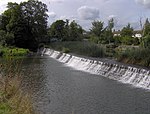Portal:Berkshire/Selected article/2
The Kennet and Avon Canal is a canal in southern England. The name may refer to either the route of the original Kennet and Avon Canal Company, which linked the River Kennet at Newbury to the River Avon at Bath, or to the entire navigation between the River Thames at Reading and the Floating Harbour at Bristol, including the earlier improved river navigations of the River Kennet between Reading and Newbury and the River Avon between Bath and Bristol.
The River Kennet was made navigable to Newbury in 1723, and the River Avon to Bath in 1727. The Kennet and Avon Canal between Newbury and Bath was built between 1794 and 1810 by John Rennie, to convey commercial barges carrying a variety of cargoes, and is 57 miles (92 km) long. The two river navigations and the canal total 87 miles (140 km) in length. The section from Bristol to Bath is the course of the River Avon, which flows through a wide valley and has been made navigable by a series of locks and weirs. In the later 19th century and early 20th century the canal fell into disuse following competition from the Great Western Railway, who owned the canal. Between 1970 and 1990 the canal was restored, largely by volunteers, and today is a popular heritage tourism destination, for boating, canoeing, fishing, walking and cycling. It is also important for wildlife conservation.
There are 105 locks on the Kennet and Avon Canal from Bristol to the River Thames, including six on the navigable section of the River Avon from Bristol to Bath and nine on the navigable section of the River Kennet to its confluence with the Thames near Reading. The remaining 90 locks lie along the 57 miles (92 km) of canal. In Bath the canal separates from the river but follows its valley as far as Bradford on Avon. The ornate Bath Locks lead to a stretch through Limpley Stoke valley with few locks. The flight of locks at Devizes, including the Caen Hill Locks, raises the canal to its longest pound, which then ascends the four Wootton Rivers locks to the short summit pound which includes the Bruce Tunnel. Pumping stations are used to supply the canal with water. The canal continues through the rural landscape of Wiltshire and Berkshire before joining the River Kennet at Newbury and becoming a navigable river to Reading, where it flows into the River Thames. (Full article...)

